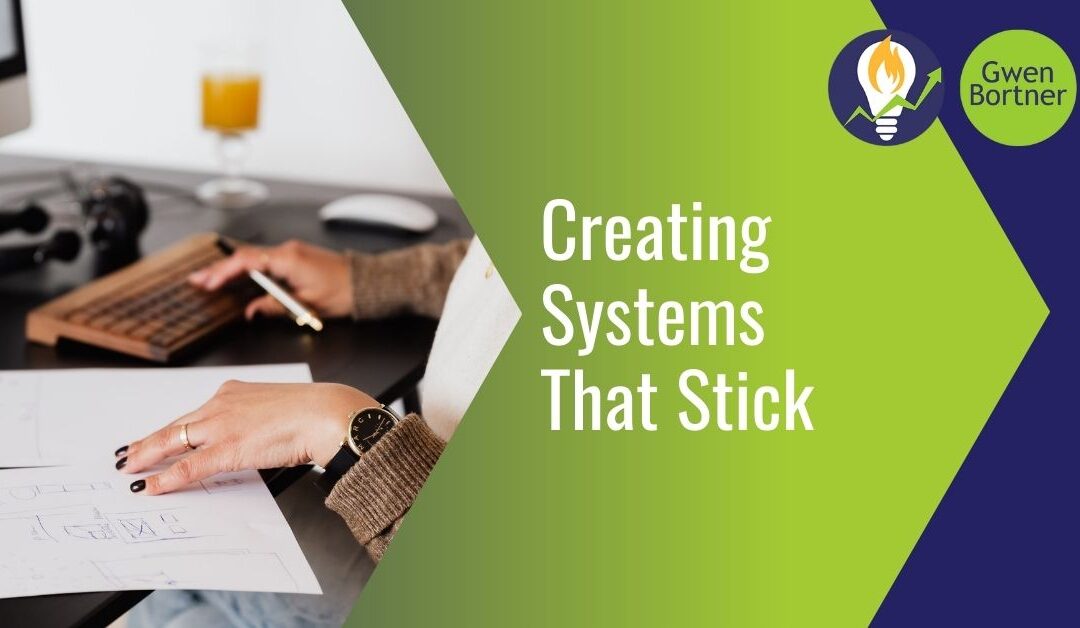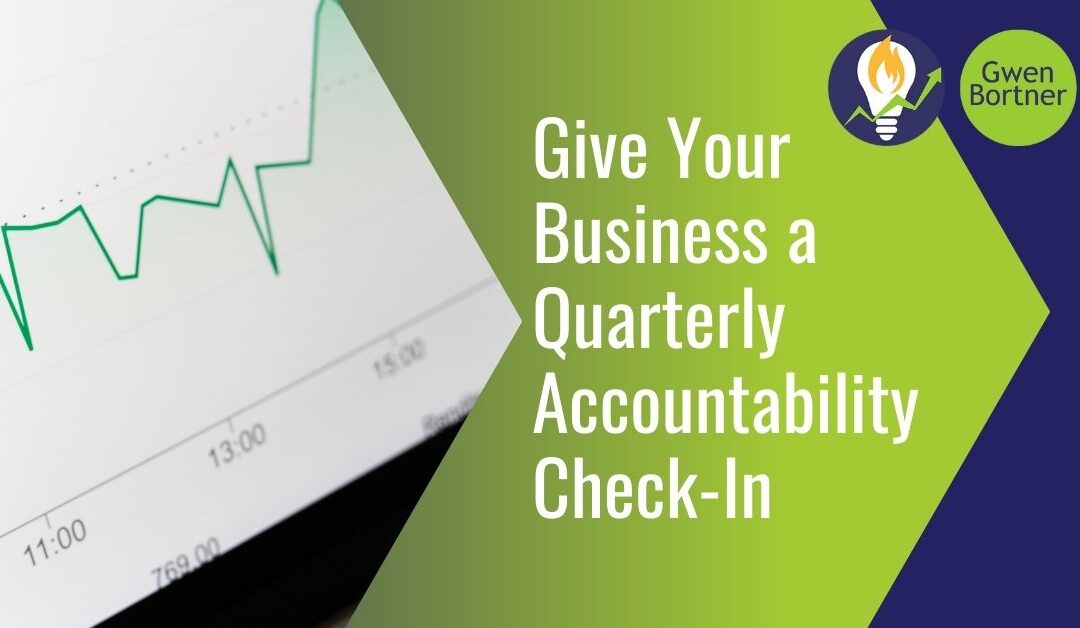
by Gwen Bortner | Operations
In case no one has told you recently: it’s okay to take some time to stop focusing on growing your business all the time, and just focus on maintaining what you’ve built. If you believe a lot of the “experts,” growth should be your only business goal; if you’re not growing, they’d have you believe you’re failing. The truth is, however, that 100% growth 100% of the time just isn’t sustainable – and if your business isn’t sustainable, that’s the real problem.
You may find yourself reaching the point where you’re very comfortable with your business where it is right in that moment, and you’re ready to just keep that level going. Other times, you may need to take a season or two to just hold your business where it is, because the things going on in your life outside of work need more of your attention. In any case, sustainability is a perfectly acceptable business plan. Being in a constant state of stress about your business is the thing that’s really not sustainable; if that’s where you are, it might be time to take a step back and focus on maintenance.
Questions to ask yourself when you’re evaluating the sustainability of your business:
1. Does my income meet all of my financial needs? Whether you want your business to supplement a household income or pay every bill, is it able to do that every month with consistency?
2. Am I happy with my income? Do you feel good about what you make, and do you feel it’s worth the amount of time and effort you’re putting into your business in order to earn that income?
3. Am I able to maintain my desired lifestyle? Remember, YOU get to decide what success looks like in your business, so now it’s time to decide: do you feel successful with the income you’re earning?
4. Am I working a schedule I’m comfortable maintaining in the long term? Does your business schedule suit your lifestyle? Are you working a reasonable amount of hours, or working yourself to death? Can you keep up with your current pace over the next several years?
5. Am I happy with the people I work with? This includes your clients or customers, employees, contractors, colleagues, and mentors. Are you surrounded by people who light your enthusiasm from within? Do you enjoy the people you communicate with in order to run your business?
6. Am I confident and content with the actual work I do? Think about the daily tasks you have to complete in your business as well as the services you offer your clients. Do you actually enjoy doing those things, day in and day out? Would you be happy doing them for the next five or ten years?
7. If I lost a client or customer, could I replace that income? The thing about sustainability is that it does require some growth; however, instead of growing bigger each year, you’re just growing to replace anything that changes or is lost. If you are able to replace clients when you lose them, then you have a sustainable business.
Once you can say “YES” to the questions above, then you’ve got a sustainable business. It’s time to just keep doing the work you’ve been doing, growing to replace or replenish rather than to increase and expand. Make sure to check in regularly with your measurable outcomes so that you know you actually are sustaining your current level of business, and you’re good to keep going for the next season or all the seasons to come, whatever you choose to do.
If you’re not quite able to confidently answer those questions, I’d love to help! Click here to schedule a call and see if for the Operations Engine, a group coaching program where we will work on fixing any misaligned GEARS in your small business. We’ll figure out where you need to make any necessary changes in order to get your business to full sustainability, and also identify the areas that are already working exactly how they should be.

by Gwen Bortner | Operations
The secret to a successful business isn’t glamorous or exciting; it’s all in the details. Creating and maintaining consistent, regular systems is absolutely essential to the overall health and growth of your business. If you don’t have a system for everything in your business, it’s time to create one.
Systems help every single person in your company do their job accurately and effectively. A good system eliminates the need for most questions, clarifies any confusing areas, and streamlines the process of onboarding new people or transitioning roles within the company. Every standard operating procedure (SOP) in your company needs its own system, and that needs to be well documented. Take a look at the SOPs in your business, and use the process outlined below to make sure each one functions as part of an effective system.
Identify the SOPs
What are the everyday procedures you follow in your company? Think about every single aspect, everyone’s role, every internal process and client interaction. If you repeat a task more than once ever, it needs a system.
Here are a few areas that might need a system in your company:
- Customer service communication (emails, phone calls, in-person)
- Customer interactions (sales, returns, leads & funnels)
- Content production (blog posts, newsletters, sales funnels)
- Social media (posting, commenting, messages)
- Financial tracking
- Goals & priorities, vision planning
- Specific procedures related to creating or delivering what you sell
- Technology issues, web maintenance
- Inter-office communications
- Chain of command explanations
- Any task that any member of your team regularly performs
It may feel redundant to document some of these things that you have been doing for a long time, but doing so helps you plan for the future of your business.
Document Every Procedure
Once you know what needs to be part of a system in your business, the next step is to document it. The goal is that a new person with a reasonable amount of skill who is taking on this task or role would be able to have an 80% chance of success in following your system without a lot of extra help. Choose an app or location to document all of your company’s systems, and begin by asking the person who currently does this task to start by making a list of the steps they take to complete that task each time.
Tip: A simple document works fine, but a task or project management app is often better, only because it allows you to duplicate the task each time it needs to be repeated, and to assign due dates or repeated cycles of the same task.
Here are some things that should be included in your documented system:
- Login information, passwords, or other access-related information
- If the task involves unique technology, a how-to for accessing or using the technology should be included (separately or within the task documentation, whichever is more appropriate)
- Brand-specific information that will be needed (HEX color codes, fonts, links to specific products, common terminology you want a person to use when completing this task)
- A step-by-step process of how to complete the task from start to finish
- Information about how to mark the task as completed or notify a person who needs to know when it has been completed
Once the system has been documented, it’s important to remember that this is a living document; it can and should change as you streamline and update the systems in your company.
Put the Systems to Work
Once your systems have been created, it will take some time to practice using them. If at all possible, ask your team members to trade tasks for one day, just to see if a person who didn’t create the procedure is still able to follow it. If that isn’t practical for your company, just make sure that the people who created the system continue to use them, and add in any updates that they notice as they do so.
The key to consistency in your business is to follow the same procedures every time; so once you have created these systems, you have to actually use them regularly. Even when a task becomes familiar or comfortable, a solid system prevents someone from missing a key step.
Do you need some help identifying and creating the systems for your business? Creating and maintaining systems is one of my favorite things to do, and I’d be happy to help you put this gear into place for YOUR business – click here to book a consultation.

by Gwen Bortner | Leadership
Money isn’t the only resource in your business, but for most people it is the one that inspires the most stress. If you don’t have your financial situation in order, it can be hard to even consider the other resources you need to manage in your business.
Is your business supporting you financially right now? Is it on track to support you in the future? If you can’t answer that with a definite “yes,” then it’s time to take stock of your business finances.
Know Your Numbers
The first step to effectively managing your business finances is to actually know your numbers. Do you regularly track the income and expenses for your business? Do you create (and stick to) a monthly or quarterly budget?
If you’ve been avoiding your financial reports because you’re afraid of what they might tell you, it’s time to get brave and dig in. If you don’t know the real numbers of your business, you won’t be able to plan for any type of financial goal in the future. If someone else manages your money, that’s fine – but make sure you’re scheduling regular time with that person to review your finances and communicate your goals, so that the two of you are on the same page when it comes to money.
Regulate Your Withdrawals
Do you regularly pay yourself in your business? How do you feel about that system – are you earning what you want to earn as the CEO of your company, or do you wish you could pay yourself more? If you think you aren’t paying yourself, double-check your monthly withdrawals. If you have been regularly taking money out of the business to cover personal expenses or “emergency” situations, then you ARE paying yourself; it’s just that your income isn’t consistent or planned.
Your business absolutely should be paying you an income; if it isn’t, then it’s time to set some goals to get yourself there. On the flip side, your business also needs to take care of itself. Are you able to regularly cover your expenses, both planned and unexpected? If you haven’t had to scramble to cover costs in the last few months, then you have a business that is financially healthy. If, on the other hand, you regularly have unexpected expenses, financial emergencies, or situations where you have to pull from personal savings to cover your business (and vice versa), then your business finances need a little bit more attention.
Fund the Future: Sustain or Scale
On a regular basis, you should be able to cover your regular expenses AND fund your business growth. That might mean that you are able to pay for additional classes, an employee or a contractor to hire into the business, or even just put money into a vacation fund. If you can’t pay for every single thing you’d like to do in your business, that’s perfectly normal; but if you can only cover the absolutely necessary expenses, then you probably need to take some action to grow your business financially in order to allow for more flexibility.
Whether you want to sustain your business as it is, or grow it to a larger scale, your finances need to support that vision. If they don’t, then maybe it’s time to get some help understanding what needs to change, where you can improve, and how to get a firmer grip on your finances. I’d love to have a frank conversation with you about your business finances, and help you get them on track to reach your goals.
Click here to book a session with me – let’s tackle this problem together.

by Gwen Bortner | Operations
Most successful business owners have mastered the art of being accountable to others. You deliver on time to your clients, you write regular checks to your team, you never miss an appointment with your mentor or mastermind group. When it comes to being accountable to yourself, are you just as reliable? Or do you let yourself fall short because no one else is on the receiving end of your accountability?
If you want your business to thrive or grow, you need to be just as accountable to yourself as you are to everyone else. Part of this means that every quarter, you set aside the time to do a check-in on your business. You need to know exactly where you stand right now, and also be able to compare your current situation to past performance in order to set goals for the future.
Right now, schedule some time on your calendar to do an accountability check-in with your business this month.
Here’s what you should be checking for:
- Numbers: Look at your key performance indicators, metrics, and financial reports from the past quarter.
- Team: Evaluate the performance of each of your team members over the past quarter.
- Vision: What are your goals for the rest of this year? How about longer than that? How close are you to achieving those goals, based on the information you’ve found today?
For each of the key areas, make a place to document your current status. A spreadsheet or document where you can keep records for each check-in together would be the best option.
As you document your check-in, make sure to record the following information:
- Where am I right now for this indicator? What is the actual performance in this area for the past quarter? (This should be something measurable – dollars, percentages, number of clients, etc.)
- How does this compare with last quarter? How does it compare to this quarter of the previous year? (If you haven’t done a check-in like this before, you may have to save this question for next quarter.)
- How does this compare with where I would like to be at this point in my business? (This is a time to celebrate any successes and reevaluate anything that isn’t working.)
- Are there any outside factors I need to note? (This might include things like natural disasters, a global pandemic, a personal health issue, a loss of a team member, etc.)
At the end of your check-in, take some time to adjust your goals if need be, and then schedule your next check-in for the following quarter right away. Prioritizing this type of assessment is key to the life and success of your business, so you have to find a way to hold yourself accountable for it, no matter how busy life gets.
If you need some help on that accountability piece, I’d love to offer you that. Book a session with me and I will help you break down your current numbers, set manageable goals, and – most importantly – hold you accountable for taking the action required to meet those goals, and to establish a regular habit of checking in on your business.

by Gwen Bortner | Leadership
When you first started your business, you were probably the only person working in that business. You had to learn to be the “Jack of All Trades” in order to get your business off the ground and keep it running. This is a solid way to start a business, but at a certain point if you haven’t transitioned out of this situation, your business isn’t going to grow.
It’s time to start thinking of yourself as the CEO of your business, and acting accordingly.
Get Clear on Your Vision
As the CEO of your business, you need a clear vision: a mission statement that details what your business does, who it serves, and where it’s going. If you don’t have a vision, then you’re just treading water, and you aren’t going to gain any momentum.
If it has been a while since you thought about your vision for your business, it may be time to revisit that. Think about what you really want from your business, and actually write down your big-picture vision. Post it somewhere that you will see it often, but also make sure to share it with your team.
Identify the Roles in Your Business
As part of your vision, think about how many roles your business needs to have in order to function properly and keep moving toward your goals. (It’s important to note that a role isn’t the same as a person; for some roles, you may have several people doing them, and for others you may have one person covering several roles.)
If you have been carrying too many of those roles yourself, it’s time to delegate them to someone else. Get clear about what you want out of your role as the CEO, and put everything else on someone else’s To Do list. As the CEO, you should primarily be your business’s leader, its overseer, and its driving force. You should not be your business’s “muscle,” doing every single task that comes through.
Now is also a good time to evaluate whether you have the right people fulfilling the right roles in your business. If not, it may be time to hire some new folks or let others go.
Communicate with Your Team
Once you have a clear vision and a solid idea of the roles that need to be filled, it’s time to make sure that everyone else on your team understands those things as well. You don’t have to have actual employees for this, though one day that should probably be your goal. For now, if you have independent contractors working for you, make sure they understand the vision you have for your company and their role in bringing that vision to life.
Here are some examples:
- Your accountant probably doesn’t need a deep understanding of your full vision, but they do need to know your financial goals so that they can make recommendations to help you reach them.
- Your assistant needs to have a firm grasp on the vision for your company so that they can help you stay true to that vision in the day-to-day tasks of the business.
- If you have more than one person in an assistant-like role, each one needs to understand the breakdown of tasks they are responsible for and who they report to on a daily basis.
- Your ghost writer or content creator needs a clear idea of the big picture so that they can communicate that with every new piece they create for you.
- Your webmaster needs to understand your goals so that they can make sure that your website is optimized to help you reach those goals.
As you look at your business with an objective lens, are you really doing the work of a CEO, or are you still playing around in “Jack of All Trades” territory? If you need some help getting clear on your vision, your team, and the roles your business probably needs to have, click the link below to book a call with me. Sometimes an outside perspective is all you need to get clear and then start taking action to align your business’s reality with your vision for it.
CLICK HERE TO CHAT WITH ME

by Gwen Bortner | Leadership
Once your business reaches a certain level, two things have to happen:
- Get very clear about what you sell.
- Set up a model that is ready for sustainability or scalability, depending on your goals.
Today I’m going to help you do just that! Sitting around thinking about your business isn’t going to get you where you want to go, so it’s time to take action.
Step 1: Get very clear about what you sell.
If you’ve hit a plateau of growth in your business, chances are it’s because you’ve been trying to make your business a custom fit for every client or customer. You change your offerings to suit everyone’s needs, and you’ve probably gotten very good at doing this, which is why people keep hiring you. The problem is that you will have a hard time maintaining that pace, and you will definitely have trouble growing your business, if you keep offering custom tailored solutions for every client.
So it’s time to narrow it down: what do you ACTUALLY sell in your business? What do you provide for your clients that nobody else provides exactly the same way? Out of everything people have paid you to do in the past, what is the strongest offering you have that also aligns most closely with your area of expertise?
In your business, what is it you REALLY want to offer your clients, with consistent quality, every single time? Going forward, that’s your offer.
Want an example?
When I talked to my business advisor about my own offering, we came to the conclusion that what I provide for my clients is accountability. Other coaches and consultants provide big-picture planning, goal-setting, and idea-generating. What I offer is the accountability for you to take the action your business needs so that you can accomplish those big-picture goals and ideas.
Step 2: Set yourself up for sustainability or scalability.
You may be focused on “growing your business,” but have you ever stopped to ask yourself if you really WANT to grow any more? A successful business does not have to mean that it’s always growing larger – a successful business can be one that is sustainable at a certain level indefinitely. Once you know what you want, you can set your business up to be that for you.
Sustainability
One scenario of a successful business could be that you are able to keep going for years, doing what you’ve been doing. You may change or tweak things here or there, but for the most part you keep consistent income, consistent working time & effort, and you provide consistent results for your clients. In a sustainable model, your business runs smoothly and effectively so that you can afford the time, energy, and finances it requires to keep it running at an even level over a desired length of time.
A lot of business owners find comfort in the routine of a sustainable business, and if that’s your goal, then you just have to make sure that what you’re offering for your clients is something you can keep offering for as long as you have your business. If you’re confident that you can maintain the number of hours you’ve been working, the current pace your workday takes on, the financial situation of your business, and the services you’ve been offering your clients, then you are good to go. If any of these areas doesn’t feel sustainable for the long-term, then that’s where you need to put your focus for improvement and streamlining.
Scalability
Maybe you do actually want to grow your business larger. What you’re earning isn’t enough for you, or you want to serve more people, or have a larger impact on your industry. Whatever the reason, wanting to grow your business is an admirable goal; however, it has to be one that is backed by a solid structure that can support that growth.
Take a look at your business operations. Are there ways that you can scale up your offering? Are you in a position to hire one or more employees to take on some of the workload? Do you see a path toward being able to take on more clients, serve larger groups of people, or increase the price of your offering? Can you take yourself out of some of the day-to-day operations of your business in order to perform more of the CEO duties, and hire others to replace you in those operations? If so, then great! You’re on your way to growing your business. If not, that’s okay, too – at least now you know what you need to work on. Take stock of the areas of your business that are hindering your growth, and focus your energy on streamlining and strengthening those areas.
Step 3: Get help along the way.
Whether you want a business that sustains itself in the long term or scales to a bigger level, it can help to have another person figuring it out with you. As I said before, my specialty is accountability; you already know your big goals, and my job is to help you figure out the action you need to take to reach them, and then also hold you accountable for taking that action. Your business can absolutely be ready to sustain your income or grow it, but you will need to streamline your operations and take the steps toward reaching the level you want for your business. If you’d like some help to do that, I’d love to help you build a business that suits your needs and meets your goals.
I would love to be the person to help you find your way. Click here to set up a time to talk.

by Gwen Bortner | Operations
If you’ve been feeling like your business is a little bit chaotic or scattered, it’s time to get some consistency. A significant factor in the success of any business is having consistent processes; not only will this increase productivity, it also improves your relationships with clients or customers and gives you a clear path to growing your business. The regular processes in your business need to be streamlined in order to be efficient and productive.
Here’s how to get there:
1. Figure out what you’re already doing well.
Being more consistent isn’t about finding a whole new way of running your business; it’s about capitalizing on what you’re already doing. You already have a product or service that you offer to every person who comes into contact with your business. Figuring out HOW you deliver that product or service is the first step to consistency. If you’ve been trying different ways of doing this, pick the one that has worked the best for you and your customer and go from there.
For example: Let’s say you have a business that involves 1-on-1 consulting sessions. Some of your former clients have sent you an e-mail, and you’ve gone back and forth with your separate calendars, trying to figure out a time that works to meet. Maybe during that process you’ve even wound up giving away quite a bit of free advice, to the point where some clients have walked away without booking a session. Another time, you tried using a shared calendar app, and booking that appointment was a smooth process that led to a successful consulting appointment. Tha shared calendar app needs to be your process from now on, with every client.
2. Stop making exceptions.
If you want to grow your business, you can’t offer a unique product or service to every customer. You need to reduce the variables between customers so that you can streamline your systems and create consistency. If you have been creating a custom package for every customer, instead try offering some options like add-on packages or a limited number of custom choices. This way you can give your customers a product that feels personalized, but you don’t have to start from scratch every time.
For example: Let’s say you have a business selling t-shirts. When you first started, maybe you would design anything on a shirt that a customer wanted. Now that your business has grown to a certain level, it makes more sense to choose your 10 most popular designs and only offer those, on a limited number of t-shirt colors. You will be able to sell more shirts because you can produce them more efficiently, but having those choices still makes your customers feel like they are getting a unique product when they come to your shop.
3. Refine and perfect your systems over time.
Just because you’re working on consistency doesn’t mean you have to lock yourself into a situation that never changes. As you go through this process of repeating your systems with consistency, you are naturally going to find ways to refine those processes and make them more streamlined. Take note of this, and be willing to adapt your processes over time. This will only add to your overall efficiency.
For example: If you run a business that involves packing and shipping a physical product, your method of shipping may change over time. You may have started with a regular home printer and the USPS website, but over time you may discover that you could outsource your shipping to a third party and free up more of your time to do other tasks. There’s no need to stick to a system that no longer works for you – this is an opportunity to build new consistency into your business.
4. Document your systems as you get comfortable.
If you’re stuck in your business, it’s often that you’re wasting time trying to remember all the things you need to do, or reinventing the wheel every time you do them. Documenting the processes can help you take those tasks off your mental load now, and also assign them to someone else later. Doing this will help you eventually hand off those tasks to someone else, such as an employee or an independent contractor. This is what makes it possible for you to scale, because you have processes that can expand to serve a bigger audience and you can hire employees to do them over time.
For example: A task management app like Trello or Asana can be a good place to document the steps in your processes, but you can also just use a Word or Google doc to accomplish the same thing. The idea is just to get your process down in writing, so that you can eventually hand that To Do List over to someone else, and stop giving it prime real estate in your own head.
5. Get help from an outside source.
It’s often hard to identify your consistent business processes internally – you have gotten so comfortable with doing all the work of your business that you don’t even realize what you’re doing most of the time. Figuring out systems is one of my stronger gifts, and I still struggle with it within my own business. It’s hard to DIY this process, but it’s also hard to hire someone to do it entirely for you. The best solution is to hire someone to work WITH you to identify and create these processes within your business. They can ask questions to get you started, and then also watch what you do as you complete your business tasks. Working together, the two of you can figure out your existing processes as well as ways to streamline them for more consistency.
If you’re wondering whether consistent processes would improve YOUR business, it might be time to get some clarity. I have a free GEARS Assessment, which will walk you through the process of evaluating your business in five key areas in order to determine which areas would benefit from some improved consistency.
Click HERE for the free gears assessment to get clarity in your business and start leveraging the power of consistency.








